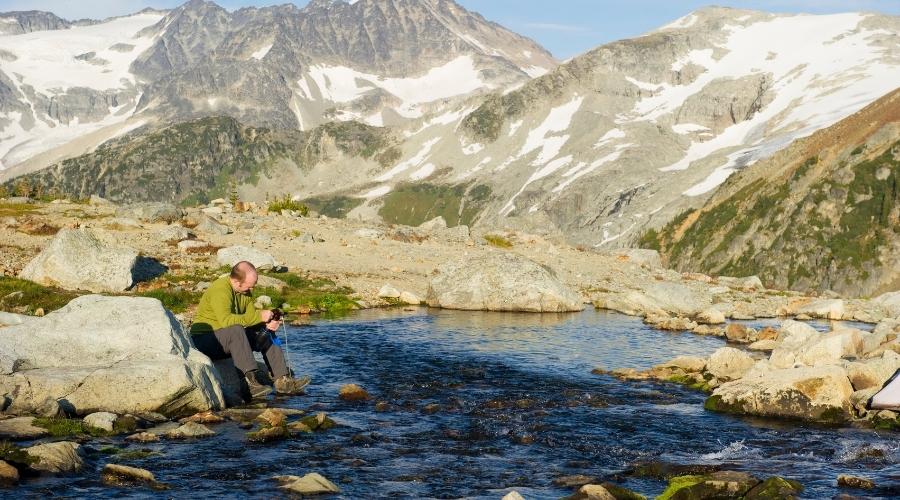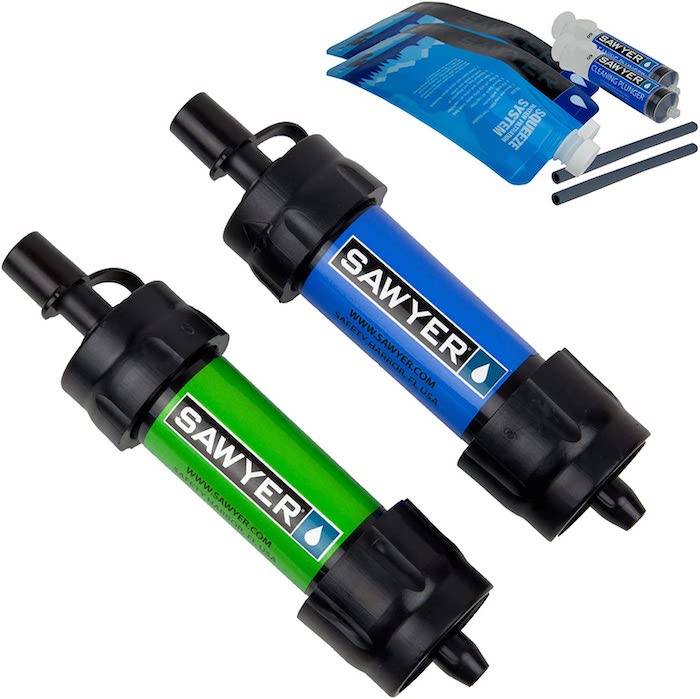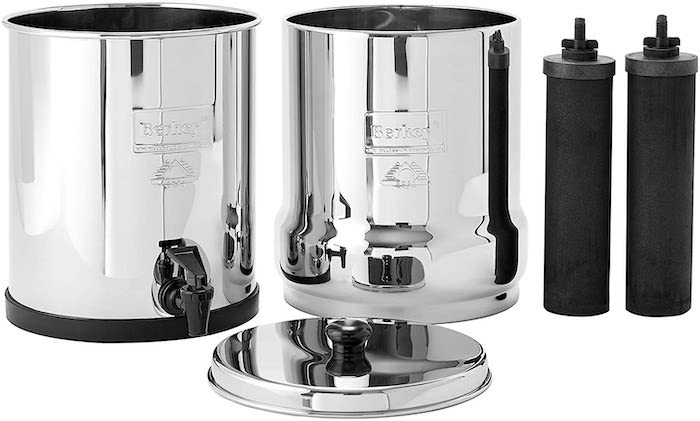Water is so important, you can only survive for about 3 days without it. So when an emergency happens it is critical that you have access to clean potable drinking water. It is important to know how to make your water safe to use for drinking and/or cooking. Whether you are on a hike needing to drink from a stream or at home and a natural disaster hits and you won’t have access to fresh water for days, having an emergency water filter on hand is critical to sustaining your life. So what is the best survival water filter to have in an emergency?
The best water filter for an emergency is one that filters out harmful contaminants, has a good filtration rate and life that filters enough water to survive for an extended period of time, is easy to use in various scenarios, is portable (if needed), and is cost-friendly.
Our Top Picks
The best emergency water filters to have on hand during an emergency include filters that do the following:
- Filter out harmful contaminants including sediment, bacteria, algae, protozoa, chemicals, metals, society’s waste, and viruses
- Good filtration rate and life that allows you to filter enough water for you and your family to survive for an extended period of time
- Easy to use in different conditions and under various circumstances
- Portable or stationary home system depending on your needs (we suggest having both)
- Cost-friendly for your budget
Jump down the page to see:
We have spent twenty-plus hours researching and testing many water filters to make it easier for you to find the right water filter that is best for your emergency and survival needs. Understanding the basics of water filters and purifying water in an emergency is important for everyone to know.
We have shared important information in this article to help you know exactly which emergency water filter is right for you and how to also purify water so that you have the best drinkable water in any emergency that you encounter.
FEMA suggests having at least two quarts (half a gallon) of water per person per day check out our water storage calculator to know exactly how much water you should store at home to meet your family’s needs. Also, it is critical that you know how to safely and easily purify water at home in case your stored water or other water sources become contaminated.
What to Know About Emergency Water Filters Before You Buy One
A survival water filter filters water by removing debris and contaminants such as dirt, soil, leaves, and animals living in the water. Water is filtered by passing through membrane microfilters made of hollow fiber membrane technology. These membrane microfilters are made of small straws that contain microscopic pores. Some water filters will even purify which filters out bacteria and parasites such as E.coli, salmonella, giardia, and cryptosporidium.
5 Different Kinds of Emergency Water Filters
- Straw- easiest filter to use, submerged one end into the water, and drink through the top.
- Bottle- a filter that screws onto the mouth of a bottle that filters water while you drink. Basically, a straw that attaches to a bottle.
- Inline- has a simple input and output point that has versatile use for bottles, bags, or straws.
- Gravity- uses gravity to help water flow from one container with dirty water through the filters to a container holding the clean water or right to a hose with an inline filter for drinking from a bag.
- Pump- use your hand to pump water through the filter.
Each of these water filters essentially filters water the same way. What it comes down to is how that water is forced through the filter. Each filter has its place, it’s up to you to decide which one(s) would be the best fit for you depending on how you plan on using it.
9 Reasons You Need an Emergency/Survival Water Filter
- Hiking – If you enjoy hiking then carrying a portable water filter is a must in case you get stranded, lost, or dehydrated.
- Backpacking – Carrying enough water during a backpacking trip is unreasonable so a good portable filter is necessary.
- Camping – Many things can happen when you’re out in the wild/nature so having a portable water filter is a must for any camper.
- Natural disasters (flooding, ice storm, tornado) – A portable and home water filter is necessary
- Local water supply is contaminated – An emergency filter will be needed for local water to be safely consumed.
- Out of bottled water – Running out of bottled water in the store, at home, or having it be stolen or even contaminated are risks that we all have to consider. Keeping emergency water filters mitigates those risks that come with storing water.
- Stranded with no clean water – It is smart to keep a portable survival water filter with you whenever you travel (in the car, on a trip, etc.) because you may run into countless situations where a filter is needed to provide potable water.
- Home water storage has sat untreated for an extended period of time or has been contaminated.
- Many risks in unknown and unfiltered water – There are three main categories of risks associated with contaminated water including sediments, biological organisms, and toxins.
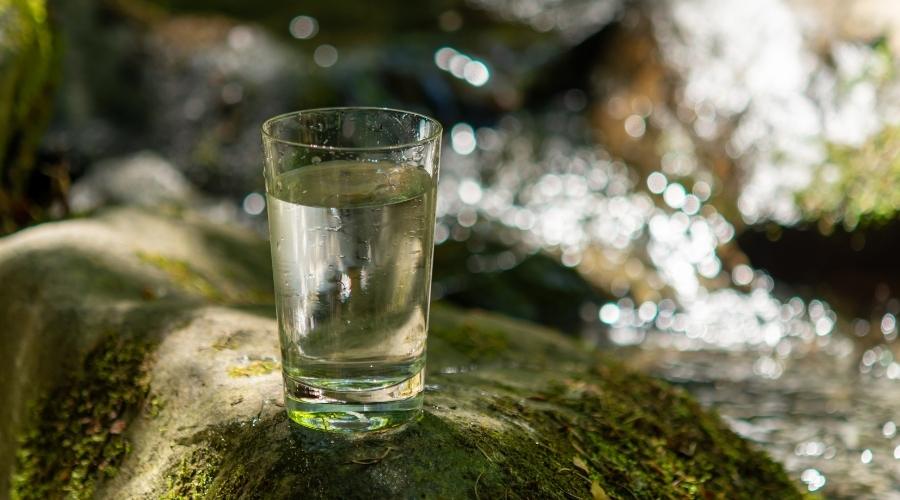
The Most Common Risks in Drinking Unknown and Unfiltered Water
The three main categories of risks with drinking untreated water are sediments, biological organisms, and toxins. More specifically the risks include the following:
- Sediment: This includes dirt, sand, silt, debris, plant, and animal matter.
- Bacteria: human and animal fecal waste, such as E. coli, salmonella, cholera, shigella, and coliform.
- Algae: Green or brown slime that grows in still water. The CDC reports that algae blooms can be harmful to people and animals.
- Protozoa: Larger, more advanced single-cell organisms than bacteria that feed on organic matter, like giardia, cryptosporidium, and cyclospora.
- Cysts: Are dormant forms of bacteria/protozoa waiting to ‘turn on’ once inside your body.
- Chemicals, heavy metals, & society’s waste: Countless contaminants like oil, pesticides, cleaning agents, acid rain, industrial runoff, paint, or heavy metals like lead and mercury.
- Viruses: Hepatitis A, SARS, polio, and HFMD (hand, foot, and mouth disease) are caused by viruses like norovirus and rotavirus.
5 Things to Consider When Purchasing a Water Filter
- Amount of water needed for a family or individual (filter capacity)
- Type of use (emergency, survival, portable, or at home)
- Cost differences between various water filters
- Usability of emergency water filter
- Durability of water filter
1. Amount of water needed for a family or individual (filter capacity)
It is critical to consider the filter capacity of any water filter that you are looking at buying. A water filter life of at least 3,000 Liters is a minimum filter life in my opinion. Some filters last as long as 100,000 liters.
There are many different options for portable water filters. Portable water filters such as straw or inline filters are great options for emergency home use or for hiking/camping. However, they aren’t the best option if you are home trying to filter water for your entire family.
If you need to filter water for a family at home a gravity filter such as the Berkey water filter, filters a large amount of water at one time as well as has a container to store the water for a short time.
You can also use a pump water filter for home use. A pump can produce more water than a straw filter and can easily be pumped into or out of a container for storage, cooking, or drinking purposes.
2. Type of use (emergency, survival, portable, or at home)
Are you getting a water filter for home use, hiking or backpacking, bug-out bags, to filter water for cooking? What you plan on doing with your water filter will help you determine which one to get.
If you plan on being close to a water source at all times a straw such as the life straw could be a great option or a hand pump filter could work great too.
If you know you won’t always be near a water source a pump or inline water filters such as the sawyer mini with a bag or bottle would be a better option so you can take some water with you.
If you are using the water filter at home with a large family the Big Berkey would be a great option.
3. Cost differences between various water filters
Prices for water filters vary greatly. Portable water filters are more affordable options and work great for emergencies and for carrying in a go-bag or backpacking bag. Home gravity filters are more expensive but hold a lot more clean water which allows a larger number of people to easily have access to clean water at once. Analyze your needs and budget to determine what filter is right for you at any particular price.
4. Usability of emergency water filter
Pick a filter that is easy to use for you, if you have a hard time bending over to the water source for more than a few minutes a straw filter might not be the best option but a pump or inline filter that you can scoop up water and move it to a more accessible spot might be your best choice.
If you don’t have much extra space, a Berkey filter might not be what you are looking for because it takes more room to store, but a pump filter could be a good alternative option for home use.
5. Durability of water filter
Most water filters have at least a life of 3,000 liters to be competitive and the best portable filters need to be durable. This can be determined by going through reviews before you purchase a specific filter. An emergency, portable water filter needs to be strong enough to withstand drops and rolling around in a backpack.
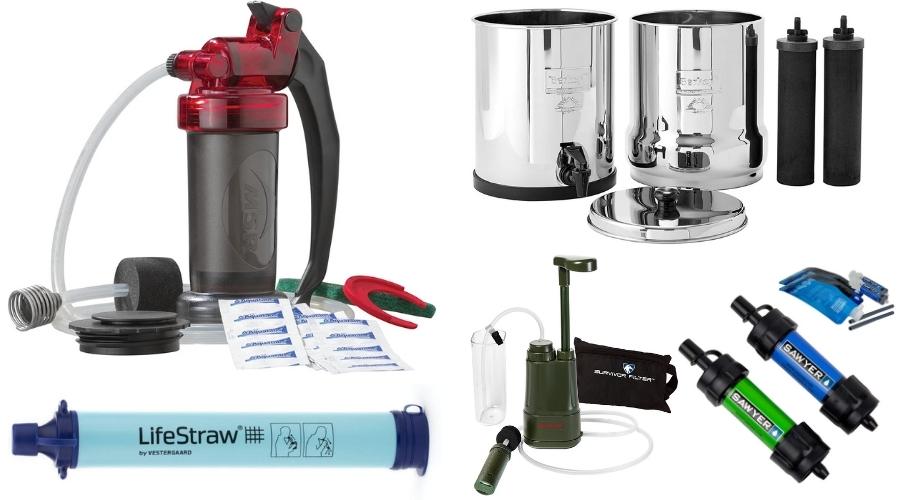
Best Portable Emergency Water Filters
If you are looking for a portable water filter some of the top things to look for are the life of the filter, and the size of the filter while maintaining all the great qualities of a good water filter.
Best straw/inline portable water filter
Sawyer Mini water filter
The best portable inline/straw water filter for its money is the Sawyer Mini water filter. It is a small lightweight water filter that is easy to take on the go that has a long filter life.
- Filters up to 100,000 gallons (10x more than the life straw brand)
- Removes 99.99999% of all bacteria
- Lightweight, only 2 ounces
- Hollow fiber membrane purification method
- LxWxH 4 x 3 x 8 inches
- Can attach to drinking pouch, standard disposable water bottles, hydration packs, or use the straw to drink directly from your water source
Check the price of the Sawyer Mini water filter on Amazon
Best Portable Pump Water Filters for Emergencies
Survival Water Filter Pro
| Type | Pump |
| Filter Capacity | 100,000 liters |
| Contaminants Removed | 200+ (anything larger than 0.01 microns) |
| Testing/Certifications | NSF 53 |
| Flow Rate | 500 Milliliters (17 Ounces) per Minute |
| Warranty | Lifetime |
Check the price of the Survival Water Filter Pro on Amazon
Tested by Intertek Labs in Columbus, Ohio, the Survivor Filter PRO can remove up to 99.9% of viruses, staph, and bacteria from the water. According to the manufacturer, it can also reduce any heavy metal content in water by as much as 99.5% for mercury and 93% for lead – something they say exceeds EPA standards for water filters.
Pros –
- Weighs in at just 10.5 ounces (300 grams) and is less than 7 inches long
- Filters out viruses, staph, bacteria, giardia, protozoa, and water parasites
- Replacement filters are readily available, and only cost about 10% of the whole filter’s price
- Comes with a handy carry case that takes up little space in a backpack
- The ultrafilters are good for 100,000 liters of water and can be easily cleaned
Cons –
- Slower filter rate at just 17 ounces of water per minute
- The pump handle feels like it could break in extreme cold weather conditions
- The included cup isn’t that big
- Filters can sometimes get clogged but washing it out will fix the problem
Check the price of the Survival Water Filter Pro on Amazon
MSR Guardian Water Purifier
| Type | Pump |
| Filter Capacity | 10,000 liters |
| Contaminants Removed | Anything larger than 0.02 microns (Military-grade) |
| Testing/Certifications | NSF protocol P248 |
| Flow Rate | 2.5 Liters per Minute |
| Product Weight | 17.3 ounces (measures 8.2 x 4.7 inches) |
Check the price of the MSR Guardian Filter on Amazon
A couple of benefits that I found with the MSR Guardian water filter versus the Survival Filter Pro (see above) are that it is built a little more sturdy, has a slightly higher certification, and has a much higher flow rate. I do like the Survival Filter Pro better still though because it has a 10x better filter capacity, seems to filter out just as many contaminants, and costs far less.
Pros –
- Sturdy build that should survive a backpacking trip
- Highly tested and certified with the NSF P248
- High flow rate of 2.5 liters per minute
Cons –
- Expensive versus the Survival Filter Pro and other comparable competitors
- Filter capacity/life is 10,000 liters which isn’t bad but is less than some competitors
Check the price of the MSR Guardian Filter on Amazon
Are Portable Water Filters Worth it?
Portable water filters are worth it for anyone who hikes, backpacks, camps, or is concerned about having access to clean potable water in various emergency situations. Having a filter on hand will be life-saving for anyone after an earthquake, flood, major storm, or any other emergency situation making portable water filters well worth the cost for anyone to have and keep in an accessible location (go-bag, hiking bag, car, at home, etc.).
Best Emergency Water Filter System for the Home
Big Berkey Water Countertop Filter System
| Type | Gravity |
| Filter Capacity | 3,000 gallons each filter (comes with 2 filters totaling 6,000 gallons) |
| Contaminants Removed | 200+ |
| Testing/Certifications | NSF 53 |
| Proces | Carbon + Ion Exchange |
| Warranty | Lifetime |
| Clean water storage | Holds 2.25 gallons of purified water |
The Berkey system is one of the most thorough filtration options available. It removes all pathogenic bacteria, protozoa, inorganic materials, heavy metals, pesticides, chlorine, and larger sediment, like rust and silt from the water. Additionally, it also reduces the majority of viruses.
When you are looking at-home water filtration systems you are probably looking at the amount of filtered water it can produce and how long it takes as well as the price. The Big Berkey water filter system is by far one of the best. The Big Berkey holds 2.25 gallons of purified water, making it a great option for small or large families.
Check the price of the Big Berkey home water filtration system on Amazon
Pros –
- Long lifespan of 6,000 gallons from a pair of filters.
- Removes over 200 contaminants.
- Large water storage capacity so you won’t need to refill very often.
- The Berkey filter does not require electricity or batteries to use (works purely by gravity).
- Berkey filters are Plastic-free.
- The system does not require it to be hooked up to your faucet so it can be placed wherever it fits best in your home.
- Berkey is suitable for well water use, which makes it ideal for anyone who lives off the grid and is looking for a simple, affordable solution for filtering their private well supply.
- Has a fluoride filter which can be useful for some and is less common in other filters.
Cons –
- The Big Berkey is pretty big so it takes up a fair amount of counter space.
- It is a gravity filter so it takes time for the water to drip through the system. It seems to take about 1 hour for a gallon of water to feed through the system.
- The replacement filters are kind of expensive but realistically they only need to be replaced once about every 3 years.
- The flow speed of filtration slows down over time so you’ll want to clean the filter elements every couple of months.
Check the price of the Big Berkey home water filtration system on Amazon
Compare the Best Water Filters by Price and Filtering Capacity
How Long do Survival Water Filters Last?
Each survival water filter’s life is different. Some are one-time use, some you can continue to use for hundreds or even thousands of gallons. Portable water filters have a life expectancy of anywhere from 50 to 100,000 gallons depending on the one you choose.
To ensure you get the most life out of your filter, there are a few things you can do to extend the life of your filter.
- Filtering cleaner water – remove as much sediment and debris as possible before filtering
- Filter running water instead of still water such as a stream or river instead of a pond or puddle
- Pre-filtering your water through a fine screen or cloth
- Backwash with clean water if/when possible
Water Sources to Use During an Emergency for Filtering and Purifying
Consider different scenarios such as a drought, flood, earthquake, or many other natural disasters. Maybe you get stranded somewhere or cut off while camping/hiking. In any situation, you’ll need to look for water sources.
Consider the following list of water sources that you can purify and then filter for drinking. Some ideas include but are not limited to:
- River or stream
- Lake or pond
- Rainwater
- Puddle
- Water storage
- Tap water from a sink or tub
What is the Difference Between Filtering and Purifying Water?
Purifying water is a process of killing/inactivating dangerous contaminants and impurities from the water such as viruses, chemicals, and other unseen matter with either chlorine, iodine, UV light, activated charcoal, or by boiling the water.
It is critical that you know how to safely and easily purify water at home in case your stored water or other water sources become contaminated.
Filtering water is a process of filtering using a mechanical device to clean the water and remove impurities such as sand and living organisms such as bacteria. When water has been filtered it may look clean but there can still be potential viruses and chemicals left behind.
To safely drink water, particularly from an unknown source, it is a good idea to have a system that can do both purify and filter or have the option to do both before safely consuming water.
For example, it could be a good practice (if possible) to boil water (purify) and then also use a filter before drinking.
How do you Filter and Purify Water in an Emergency?
The best way to filter and purify water in an emergency is to remove sediment and debris, purify the water by boiling or treating it with bleach or chlorine dioxide tablets, and then filter the water using a good water filter.
- Remove sediment and debris
- Purify the water by boiling or treating with bleach or chlorine dioxide tablets
- Filter the water by using a good reputable water filter (see options above)
Steps 2 and 3 can be done in reverse order depending on your individual circumstance.
Filtering and purifying options
- Water Filter
- Boiling
- Unscented chlorine bleach
- Chlorine Dioxide tablets
Water filters are the safest way to ensure you are drinking clean water when used correctly. Water filters can remove 99.999% of disease-causing parasites such as Giardia and Cryptosporidium. Many portable water filters remove 99.999% of bacteria including E.coli, salmonella, and cholera.
To purify water by boiling, water should be brought to a rolling boil for at least 1 minute. If you are above 5,000 ft. in elevation, boil for at least 3 minutes. If the water is still cloudy, it can be strained through a clean cloth or coffee filter
If you don’t have a water filter and boiling water is not an option, using unscented chlorine bleach is also an option. The United States EPA website states that you should only ever use unscented chlorine bleach, products that are suitable for disinfection and sanitization as indicated on the label. The amount of water you are purifying determines how much bleach you should use. See the chart below. Once you have added the correct amount of bleach, stir the water and let sit for 30 minutes. The water should have a slight chlorine smell. If not, repeat the process of adding bleach and let sit for 15 minutes. If the taste of chlorine is too strong, pour water into a clean container and let it stand for a few hours before use.
| Volume of Water | Amount of 6% Bleach to Add* | Amount of 8.25% Bleach to Add* |
| 1 quart/liter | 2 drops | 2 drops |
| 1 gallon | 8 drops | 6 drops |
| 2 gallons | 16 drops (1/4 tsp) | 12 drops (1/8 teaspoon) |
| 4 gallons | 1/3 teaspoon | 1/4 teaspoon |
| 8 gallons | 2/3 teaspoon | 1/2 teaspoon |
*Bleach may contain 6 or 8.25% sodium hypochlorite.
When purifying water it is best to use water from a clean stream, or fresh rainwater. If you find yourself in a situation where those are not options you want to avoid using surface water and water that has lots of debris or a foul smell.
According to the CDC, bottled water is the best option for water, other common ways to purify water are boiling the water, using a small amount of unscented chlorine bleach, and using chlorine dioxide tablets.

